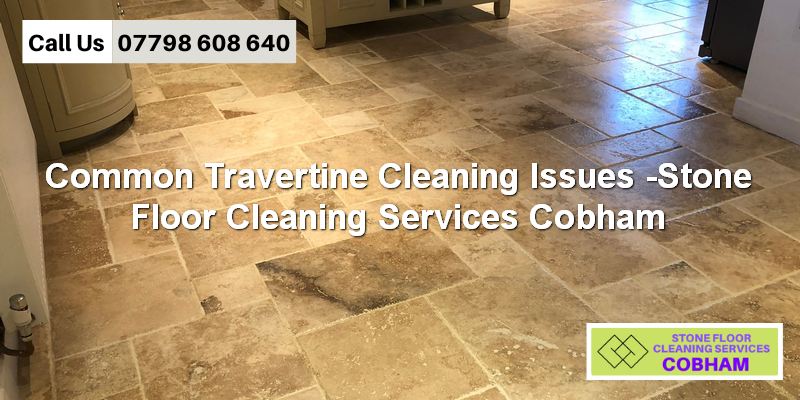Help With Common Travertine Cleaning Problems

Travertine is a beautiful, natural stone used in home construction and design. It is used in flooring, countertops, backsplashes, and outdoor features like patios and pool decks. While Travertine is durable and resistant to stains, it does require regular cleaning and maintenance to keep it looking its best.
Common issues that arise when cleaning and caring for travertine surfaces.
Removing Stains from Travertine
Accidents happen, and sometimes stains can occur on travertine surfaces. The best way to remove a stain from Travertine depends on the stain type and severity. For example, you can blot up a fresh spill of red wine with a clean cloth before it stains, while an older stain may require more aggressive treatment. Some standard methods for removing stains from Travertine include:
- Using a commercial stone cleaner and following the instructions on the label
- Make up a paste with baking soda and water, and apply it to the stain, then scrub gently with a soft-bristled brush
- Apply a poultice, a paste made of a stain-absorbing substance (such as talcum powder or diatomaceous earth) mixed with a solvent (like water or rubbing alcohol). The poultice is applied to the stain and covered with plastic wrap to allow it to absorb the stain, then the paste is removed, and the area is rinsed and dried.
Cleaning and Polishing Dull or Scratched Travertine
Over time, Travertine can become dull or scratched from everyday wear and tear. Professional travertine contractors specialist travertine cleanners and fine polishing powders to clean and polish Travertine.
For deeper scratches or etch marks, they use diamond impregnated pads to remove the damage and prepare the floor for polishing.
Removing Soap Scum or Hard Water Deposits from Travertine
Soap scum and hard water deposits can build up on Travertine, especially in showers and sinks. To remove these substances, don't be tempted to use a commercial bathroom cleaner, a vinegar solution.
Spray some ph neutral travertine cleaner onto the solution onto the affected area, then scrub with white cleaning pad and rinse thoroughly.
If your cleaning is not sucessful, call on professional help.
Maintaining the Natural Shine of Travertine
It's essential to maintain the natural shine of Travertine. In addition to regular cleaning and polishing, this may include sealing the surface to protect it from stains and damage. Travertine is a porous stone that can absorb liquids and colours when not adequately sealed. To determine if your travertine surfaces need sealing, place a few drops of water on the surface and see if it absorbs quickly or beads up. If it absorbs quickly, it's time to apply some sealer.
Cleaning and Sealing Travertine to Protect it from damage
To clean and seal your travertine surfaces, you should begin by dusting or sweeping the area to remove any loose dirt or debris. Next, mix a small amount of pH neutral travertine cleaning chemical with warm water and scrub the surface with a soft-bristled brush or a non-abrasive sponge. Rinse the surface thoroughly and let it dry completely. Once the Travertine is clean and dry, it's time to apply the sealer. Follow the instructions on the sealer carefully, as the application process may vary depending on your chosen product. There are two types of sealers: impregnating sealers, which penetrate the stone's surface to protect it from within, and topical sealers, which form a protective barrier on top of the rock.
Removing Mold or Mildew from Travertine
Mould and mildew can grow on travertine surfaces, especially in damp or humid areas like bathrooms.
To treat mould or mildew on your Travertine, spray the area with a mould and mildwe treatment. Scrub the surface with a soft-bristled brush or a non-abrasive sponge, then rinse thoroughly and dry. If the mould or mildew persists, you need to seek professional help.
By cleaning and maintaining your travertine surfaces, you can keep them looking beautiful and protect them from damage. Remember always to use gentle, non-abrasive cleaners, avoid harsh chemicals, and seal your Travertine to prevent stains and damage. With proper care, your travertine surfaces will remain a stunning home feature for years.
Frequently Asked Questions About Travertine
What is the best way to clean travertine tile?
Clean travertine by removing dry soil with a dry mop or vacuum cleaner. Then damp mop using a microfiber mop and a Ph-neutral travertine cleaner. If there are stubborn marks, spray some Ph-neutral cleaner onto the marks and leave for 5 minutes before mopping.
How do I clean and restore travertine?
A homeowner can clean travertine using a microfiber flat mop nand a Ph-neutral travertine cleaner. Repair and restoration work is best done by professionals who have the right equipment and experience.
Does vinegar ruin travertine?
Vinegar is an acid, so it will dissolve Travertine. If you spill some vinegar and wipe it up, the spill will leave a dull mark on the stone, called an etch mark. Etch marks need to be honed and polished away by a professional restoration company
Frequently Asked Questions About Travertine
What is the best way to clean travertine tile?
Clean travertine by removing dry soil with a dry mop or vacuum cleaner. Then damp mop using a microfiber mop and a Ph-neutral travertine cleaner. If there are stubborn marks, spray some Ph-neutral cleaner onto the marks and leave for 5 minutes before mopping.
How do I clean and restore travertine?
A homeowner can clean travertine using a microfiber flat mop nand a Ph-neutral travertine cleaner. Repair and restoration work is best done by professionals who have the right equipment and experience.
Does vinegar ruin travertine?
Vinegar is an acid, so it will dissolve Travertine. If you spill some vinegar and wipe it up, the spill will leave a dull mark on the stone, called an etch mark. Etch marks need to be honed and polished away by a professional restoration company